|
|
 |
Kaase Does it again... 2013 Engine Masters Challenge Champion!
It was the year of the Ford mod motor at the 2013 Amsoil Engine Masters Challenge; 1st, 2nd, and 3rd place were dominated by the quad cam beasties from the Blue Oval. John Mihovetz from Accufab held first place all week with BES Racing Engines just behind, but during the finals Jon Kaase pulled out all the stops and managed to push ahead for the win!
|
 |
 |
 |
 |
 |
 |
 |
 |
 |
 |
|
 |
|
|
|
Kaase pulls out another win at the 2009 Engine Masters Challenge!
In eliminations we run the qualifying engines from lowest qualifier to the top finisher, leading to the top qualifier. In last year's event we made a change to keeping the score silent right up through the elimination field, so competitors have no idea of the outcome until the final engine has run. Without knowing the number to beat, each team is giving it all they have vying for the title of "Engine Master." When all the dust settled, Jon Kaase Racing inched out a victory by just a fraction, taking top honors over second place finisher BES Racing by just 1.4 points! The rest of the field fell in line in the same order as qualifying, with Hot Heads / Gene Adams Performance finishing third, Performance Crankshaft in fourth, the School of Automotive Machinists in fifth, and Jon Kaase's Boss in sixth position.
|
|
|
|
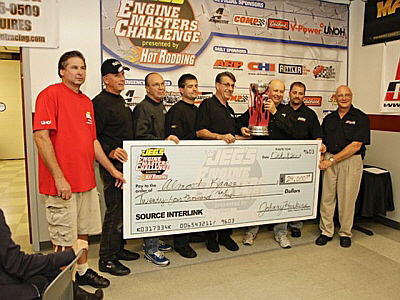 |
|
|
|
The 2008 JEG'S Engine Masters Challenge winner is - Jon Kaase Racing with final score of 2,587 @ 403 cubic inches using the NEW Kaase C-400 CHI cylinder heads!
The Finals
We went into the finals with a new format in which the competitors are blind to the scores until the end of the competition. In contrast to previous years in which the scores are revealed while working through the ladder, the score required to win was anyone's guess. With this format, there would be no sandbagging or holding back, as competitors gave it everything their engines had. When the dust cleared Jon Kaase prevailed to win the 2008 Engine Masters Challenge with his phenomenal Cleveland Ford. With a low-end torque hit at the bottom of the rpm range that resembled a bulldozer, the points for the Kaase team piled on for a convincing win.
|
|
|
|
 |
|
 |
 |
 |
|
The New Kaase Boss Nine Cylinder Heads Finish 3rd in Their 1st Engine Masters Competition! 2008
Jon Kaase is a veteran Engine Masters competitor and two-time champion, so there always attention when this team enters the test cell. This year there was a special treat in store for Engine Masters fans, with the debut of Kaase's brand-new "Boss 429" cylinder heads and top-end package. The Boss engine is a larger-than-life relic of the factory musclecar wars, and original parts are exceedingly rare. After last years Challenge Kaase went to work to develop this modern version of the famous Boss, and for his effort captured the 3rd place finish.
|
|
 |
 |
 |
|
Kaase wins 2004 Engine Masters Challenge with 3v 225 CHI Heads!
Jon Kaase is no stranger to the world of ultra high performance engine building and the incredibly slick Ford 408 Cleveland he brought this year was by far the most exotic mill in attendance. With its Australian CH1 Cleveland heads, AMC six-cylinder main bearings and .5-inch thick copper head spacers, it was number one qualifier with peak readings of 698.2 hp, 619.6 lb.-ft, average power readings of 485.9 hp and 557.3 lb.-ft. and a staggering 1,043.2 points.
We asked Jon if there was anything left in the 12.4:1 compression Ford Cleveland to be unleashed for the final rounds and he said, "I've got the timing back as far as it will go (24 BTDC) and still make power so jetting is all that's left." During the warm-up pulls the motor easily made in excess of 650 hp despite audible levels of detonation. During the tuning period Jon had his hands full. Not with the engine, of which he declared, "No tuning required," but with the TV cameras and an interview with Speed TV's Ken Stout. Stout was there taping an episode of the upcoming series "Lucas Oil...On The Edge" and Jon spent several minutes talking about the Engine Masters Challenge while the silent Cleveland cooled off prior to the final competition pulls.
With the Hollywood action out of the way, the motor was started and the competition pulls commenced. The amazing result was peak output of 691.2 hp and 616.2 lb.-ft., average output of 485.9 hp and 557.3 lb.-ft. for a total score of 1,043.2 to win the Engine Masters Challenge. Sharp readers will note that Kaase's qualifying and eliminations point scores are identical. It's no typo, Kaase was the only contestant to get the hat trick. Coincidence or not, it earned him the nickname Kaase the Konsistent.
|
|
 |
 |
 |
|
Kaase wins 2003 Engine Masters Competition with SCJ Big Block Ford!
Jon Kaase (pronounced KAH-zee) developed a Challenge-winning formula based on a Ford Motorsport A-460 block, but that is only the beginning. Extensive block modifications were completed, drawing on Kaase's extensive experience in IHRA Pro Stock. In his own words, Jon shared the technical developments with us.
"Like most in this business, I love nothing more than healthy competition. Entering the Engine Masters Challenge, I figured there would be plenty. What I'd not anticipated were the rewards of the process itself. There is much that I learned during this experience that will soon find its way into our 815-inch engines. Moreover, I got to better know people I respect with whom I deal on a regular basis and whose work I've long admired. Those with whom I'd not worked before but have gotten to know along the way have, happily, become friends and associates, as well. Forget what the commercial says, this is the stuff that's 'priceless.'
"Our entry's dimensions and chamber design were pretty much finalized after a consult with "W.J." My Pro Stock mentor from nearby Sugar Hill confirmed what I believed to be true: a small chamber with lots of quench and turbulence was the way to go. 'Detonation Prevention 101' soon began, as the whole engine was built on that premise. A long stroke combined with a short rod would produce very fast piston action at top dead center. This should liven things up. I like short rods anyway. Two inches longer than the stroke--it works on a 5.0 Ford as well as an 815-inch IHRA Pro Stocker.
"When planning our Engine Masters Challenge entry, I knew that there would be no going back once I committed to rod length, bore and stroke. Because of the low test rpm range, I felt I needed the longest stroke and smallest bore with which the heads would work. With pump gas, detonation was a huge factor in the design of the short-block and heads. A smaller bore has less chance of detonation because it doesn't have some far-off place for a secondary flame front to start. The 460 Ford block starts out at 4.360, which I felt was too big. The smallest bore the heads would flow reasonably well on was 4.250-inch. The intake valve still had ample room between the valve head and the bore, but the exhaust wouldn't even open until I ground a huge notch in the top of the cylinder. The stroke needed for 468-inch would be 4.125-inch."
THE BLOCK
"The majority of labor in this engine was the in the block. The A-460 block was bought used from Total Performance in Michigan. Since we had to sleeve the bores down, I found some ductile iron sleeves on Darton's web page. Because of the long stroke and short rod, the wrist pin centerline area of the piston extended completely out of the cylinder at BDC. The trick was to bore the block to 4.650-inch, and extend the sleeves down into the crankcase to help support the piston. The sleeves had a small flange at the top, and the bores required a counterbore to keep the sleeves in place, since there was nothing to catch on at the bottom. We used the big O.D. sleeve so it would have wall thickness and strength where it protruded out of the crankcase."
Bearings were all by Clevite, with PN MS963P (2.499-inch diameter) mains and PN CB745H (1.999-inch diameter) rod bearings. All the bearings were anti-friction coated by Calico Coatings. Bearings are now sold pre-coated by Calico.
"Ford's new Super Cobra Jet cylinder head was a perfect match for this competition. The favorable valve placement allows superb airflow at medium valve lifts. In all the testing we've done, they seem to require about ten degrees less cam timing then all other performance cylinder heads. This worked to my advantage, since the less cam timing you have, the better the power will be in the lower third of the rpm band. The spark plug is centrally located in the chamber and requires less timing, which helps with the detonation prone pump gas. A good example of how good these heads are is Randy Malik's number one-qualifying Michigan-based entry. He spent less money on his whole engine than I had in my block and crank! His heads weren't even ported, with just a little grinding in the valve bowls.
|
|
 |
 |
 |
|
"I would like to have tried different compression ratios, but in the end it worked out perfectly. At 13.2:1, it was just right for 28.8-inches of barometer. In Memphis, at 29.8-inch, it was a little too much. This high compression would never have worked with a big, lazy chamber. Fortunately, the barometric pressure at Westech was just right for my combination."
The valves are from Victory 1, with the intake valve measuring 2.190-inch and 5.600-inches long. The exhaust valves have 1.695-inch diameter heads, and also measure 5.600-inches long.
"The Victor 460 (PN 2965) by Edelbrock is a wonderful manifold to work with. It makes great power right out of the box, and is hard to improve on. Where the ports meet the cylinder head, I left it the 'as cast' size for initial testing. When we reduced the head's intake port size, the manifold port floors had to be epoxied up to match the head. Toward the end of testing (at the suggestion of Sonny Leonard), we welded half-round ears to the four corner dividing walls in the plenum chamber. This helped about 10 ft.-lbs. from 3,000 to 3,500 rpm, and stayed the same the rest of the way up."
|
|
 |
 |
|
"My 25-year friendship with Sonny Bryant made choosing the supplier of a crankshaft for this project a no-brainer. At $2,850, the crank is the most expensive part in the engine, but it's a work of art. Sonny used 340 Chrysler mains (2.499-inch), small Chevy rods (1.999-inch) and the final product weighs 64 pounds. It had small diameter counterweights considering the 4.125-inch stroke, and required 20 pieces of Mallory achieve the 2,100-gram bob weight. I decided on the 2.5-inch main size because the smaller 302 Ford size (2.250-inch) may have made the crank too flexible with its long stroke.."
|
|
 |
 |
|
Connecting rods are by Carillo, weigh 600 grams. They measure 6.250-inches, center-to-center. These high-strength steel rods can be custom-made in any dimensions. "Even with the $2,500 contingency money tempting me, I could not bring myself to use a set of $500 rods in this engine. I found a new set of Carrillo rods at Gary's Used Race Car Parts in High Point, North Carolina. Priced at $1,000, they were $750 cheaper than my normal price. The spec card listed them as custom built for Richard Childress Racing in 1998. It hit me then; these were Earnhardt's rods. Because they were offset for small-block Chevy use, the pin end did not reside in the center of the big Ford's piston. I needed to cut new bearing notches in the opposite side of the housing bore, chamfer the other side of the big end, and turn the rod around. The bushings were pressed out bored for a .990-inch pin. The Casidium-coated wrist pin was run directly on the steel rod end."
|
|
|
 |
 |
 |
 |
 |
 |
 |
 |
 |
|
 |
|
|
|
The pistons were crafted by Venolia, and must be some of the strangest we've ever seen. They are a relatively tall design, and incorporate much of the combustion chamber into their decks. Pin length is 2.930-inches, and pin weight is 150g. The pins were coated with Casidium to prevent scuffing, which is becoming a popular move among racers of all disciplines. The pistons themselves were coated by Calico. We did hear rattling between 3,000-3,500 rpm, but it cleared up completely after that, and power began to skyrocket.
|
|
|
|
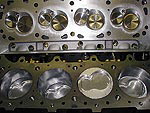 |
|
|
|
Also, the dish and intake valve relief in the piston dome were .300-inch deep, so the top ring groove needed to be at least .150-inch farther down. The quench areas of the piston dome were .600-inch thick and, after much internal debate and contemplation, I left them alone with no lightening. I felt the piston would take longer to heat up and forestall the detonation process; at least for a short while it would be a heat sink. I wasn't too worried about weight because the contest runs were made at 300 rpm per second acceleration rate. At 600 rpm per second, it would have been a big problem. I believe that the ring being farther down and away from the heat saved me at the Memphis test."
|
|
|
 |
 |
 |
|
The HVH carb spacer (four hole-to-open) measured 1.8625-inches tall.
"I also ground the intake's plenum entry to a square shape (from the original cloverleaf design) to match the HVH carb spacer."
"I chose the BG King Demon for its adjustability. This proved to be very valuable in dyno tuning the fussy pump gas throughout the entire rpm range. We changed the venturi size several times until the engine would take a steady load at 3,000 rpm, but not lose power at 6,500. We had to find the right combination of venturi size, booster, air bleed, emulsion holes and main jet. Getting all the various components working together was yet another learning experience and no easy task, but, ultimately, I'm glad the adjustability was there." All Jon Kaase's fuel fittings were from Earl's, and he crafted the pieces together from loose stock to get the final product. The Engine Masters Challenge-spec 14x3-inch round air filter was a Cool Blue unit from Accel (by Mr. Gasket) and caries PN KR3007.
The ignition system is comprised of all MSD products, from their 7AL-2 box (PN 7220) through the distributor (PN 8580) to the wires (MSD's Super Conductor 8.5mm) to the coil (MSD's HVC II, PN 8261).
"We used MSD's distributor, plug wires, coil, and control box. I was shocked that the engine needed the same timing at 3,000 as it did at 6,500 rpm. I would have lost a bet on this one as I figured much time would be spent getting the advance curve right. In the end, the distributor was locked with no curve."
Spark plugs are from Accel (PN 762) and were gapped at a typical .035-inch.
|
|
 |
 |
 |
|
Headers are Hooker's Super Competition (PN 6201) for '71 Mustangs with 429/460 engines. The pipes are legal for the Challenge, even though they are multi-piece. While full multi-piece headers were not allowed per the rules, partial multi-piece headers like these (where a single pipe had to be crafted to go outside the unmodified factory frame rail, but the rest of the header was a single-piece unit) were specifically called out as legal per our 2003 rules. If this is the kind of header street guys need to run in cars with tight engine bays, and no mods were required to install them, we're on board. The pipes have a 2.125-inch primary diameter, with a 3.5-inch collector diameter. Primary tube length is a longish 37 inches, which Kaase felt contributed to solid torque figures. These headers will also fit '70-'71 Torinos, Rancheros, and Mercury Montegos with the 429/460 engine. The headers were teamed with Magnaflow mufflers during Challenge testing.
"I'm glad there were almost no choices for headers. I may have gone bankrupt buying different sizes and lengths. The five-year-old Hookers we use for dyno testing were sent to Swain Tech for coating. I was a believer in this heat coating after repeated dyno pulls were made with an unharmed plastic line in close proximity of a primary pipe. I know it would have burned up near an uncoated pipe.
|
|
 |
 |
 |
 |
 |
 |
 |
 |
 |
 |
 |
 |
 |
 |
 |
 |
 |
 |
 |
 |
 |
 |
 |
 |
 |
 |
 |
 |
 |
 |
|
 |
|
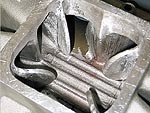 |
|
 |
|
|
|
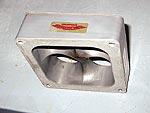 |
|
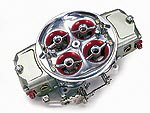 |
|
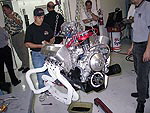 |
|
|
|
"During the last two days of testing I finally forced myself to hook up the dreaded mufflers. Difficult as it is to believe, this elicited the largest single gain of any parts tested. At least part of the improvement was due to a mistake I made when ordering collector extensions. Looking in the Hooker catalog, I apparently experienced a 'senior' moment and transposed the part number, ordering 3.250-inch diameter collector extensions instead of 3.5-inch. Who ever even heard of 3.250-inch collector extensions? To make them work, I expanded one end to fit over the Magnaflow 3-inch muffler entry. The front end was easier to reduce its diameter to fit INSIDE of the 3.5-inch header collector. This combination of extensions and mufflers increased the low-end torque by 50 ft.-lbs.! I am convinced that the smaller diameter extensions I mistakenly ordered were a large part of the torque gain and may have even made the difference in winning or losing the contest!"
The oil pan is a Moroso part designed for '79-'95 Mustangs/Capris and all other Fox chassis cars with 460 swaps, and chassis mods are not required for it to fit. It was designed by Moroso to clear the factory crossmember and steering linkage when a big 460 is dropped into a Fox chassis, which is precisely the kind of part we wanted to see in the Challenge. It carries Moroso PN 20620 and measures 9-inches deep with a seven-quart capacity. The pan was filled with Royal Purple #41 oil, which has a viscosity rating of 10W-40. Again, for those thinking it would take watery oil to win the Engine Masters Challenge, Kaase proved this was not the case. The lubricant was filtered through a System One filter, which we like due to its serviceable filter element. You can clean it and re-use it instead of having to throw it out, which saves you cash and is better for the environment.
|
|
|
|
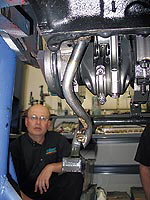 |
|
|
 |
|
 |
|
|
|
|
|
|
"I would have preferred a front sump pan on this stationary engine, as the pump is in the front. Unfortunately, none of the contingency sponsors offer a front sump 460 pan. I wanted Moroso's money badly enough to devise ways of making their only legal rear sump pan perform efficiently. The theory is that light tension oil rings can't control mass quantities of oil, and as oil works past the rings into the chamber, it will surely detonate and lose power. Any extra oil in the crankcase will try to slow the assembly's rotation (throw a bucket of water into a fan and see if it doesn't slow down)."
The tube you see in the photo is purely for support; the tube carrying oil to the pump runs from the rear of the engine to the front, and can be seen extending from the pickup out of the photo.
|
|
|
|
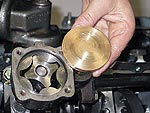 |
|
|
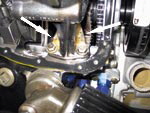 |
|
|
 |
|
|
|
|
|
|
"The Calico-coated main and rod bearings were tightly fitted to .002-inch clearance. The stock 3-inch mains need much more oil flow than our engine's 2.5-inch units. The oil from the lifter galleys could not drain through the cam area and dump on the crank because of the covers installed in the cam tunnel. The cam was always submerged in oil for better lubrication and cooling.
"I have countless times seen oil pumps break off in the 460 Ford. To prevent this, we brazed steel gussets to the pump at its weakest point. The pump was also fitted with low-volume 1.1-inch rotors, and the bypass spring was shortened by two coils. The small bearings with tight clearances simply don't require much oil.
"The biggest problem encountered by all of the Challenge entrants was that flat tappet lobes have evolved into very aggressive designs geared toward steel billet satellite welded cam cores. NASCAR engines use these cam cores but require extremely strong valve springs to control the valve action."
Kaase's research cost him three camshafts, for various reasons. Each cam problem caused another rebuild, and his perseverence wouldn't let him stop.
"Another call to Gordon at Comp Cams began rebuild number three and cam number four. Because of the non-effect of the lash changes on cam number three, Gordon decided to go 4 degrees larger on both intake and exhaust. We were now at 256/264, 108-degree CL, .390-inch lobe lift, and .675-inch valve lift. Of course, I had to press all the homemade bearing races off the old cam and re-install them on the new one.
"After much trial and more error, I have a greater understanding and appreciation of flat tappet cams! Thanks goes to Scooter Brothers of Comp Cams for supporting me, and the Engine Masters Challenge as a whole."
That's Scooter congratulating Jon with the Engine Masters Challenge trophy.
The timing belt was by Comp Cams, as were the pushrods. Carrying PN 7918 (intake side; 9.0-inch length) and PN 7755 (exhaust side, 9.4-inches long), the pushrods are moly and plenty stiff for a 6,500 rpm street engine. The 1.73:1 rocker arms are Crane's aluminum full-roller pieces for the 460 Ford. They worked against a set of LSM valve springs, which have a 1.550-inch diameter and 130lbs. of pressure on the seat at their recommended 1.950-inch installed height. The springs carry PN 422 at LSM.
|
|
|
|
 |
|
|
 |
|
|
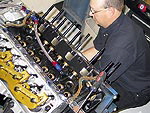 |
|
|
|
|
|
Coolant was circulated by a Wei and mechanical (belt-driven) pump. Jon was the only builder in the Challenge who did not run an electric water pump, and he won. Myths were getting busted all over the place.
"I'd have preferred to run an electric, but Weiand was the only water pump contingency sponsor, and they don't offer one. The mechanical unit worked just fine."
To summarize the details within Kaase's Challenge winning Ford, the starter is a PowerMaster product, and carries PN 9505. It's rated at 200 ft-lbs and is designed to crank over even the toughest high compression 429/460 Ford with ease. The fasteners in Kaase's engine were ARP products. The quality of ARPs hardware has never been questioned, and good ARP bolts are cheap insurance for your heavy engine investment. Kaase relied on Cometic gaskets to seal the deal. We've seen Cometic grow tremendously from the first Engine Masters Challenge, and they're ability to offer custom-crafted products with minimal turnaround time are finding great favor with Challenge participants. Top-quality materials and the ability to create oddball bore size head gaskets that can ship within a couple weeks sure helps.
The engine was coated with Dupli-Color paints and sealed up with Permatex sealants. It looked good and ran great without leakage, so we know both of these products are good, too.
The back of the engine was home to a TCI flywheel and a Lakewood bellhousing. Both of these critical components needed SFI approval to be legal for our Challenge, and this certification means they're plenty tough for street and race use under your car. Safety is a major consideration when buying both high performance flywheels and the bellhousings they'll live in. We'd like to thank Jon Kaase for sharing everything inside his engine so openly with our readers, and to congratulate him once again for proving to all he is this year's Engine Master!
SUMMARY
So, how did participating in the Engine Masters Challenge affect a veteran professional engine builder like Jon, whose engines have won several World Championships?
"I invested year of planning, laboring, and $20,000 in parts; all for those three 12-second Engine Masters Challenge Finals dyno pulls. Just whose idea was this?
"In my 35 years of building race engines I have never been as nervous as I was during those three runs. The last run seemed to take forever. What a relief when it was over, and the final score was 1,178, and I was declared the Winner!
"The one thing I most wanted to do for months was to be able to call home and tell my family and my guys at the shop that I'd won. What an awesome feeling! Now I could touch the trophy.
"I cannot say enough about how great all the people involved in the Engine Masters Challenge were. The competitors were all friendly, like-minded guys, eager to meet one another and exchange stories about their journeys. The crews at both Comp Cams and Westech did everything but spread rose petals for us to walk on.
"Many thanks go out to both Scott Parkhurst and Michael Simpson of Primedia for a wonderful experience. They've given engine builders a place to compete and showcase their talents on a personal level."
Jon Kaase
|
|
|

